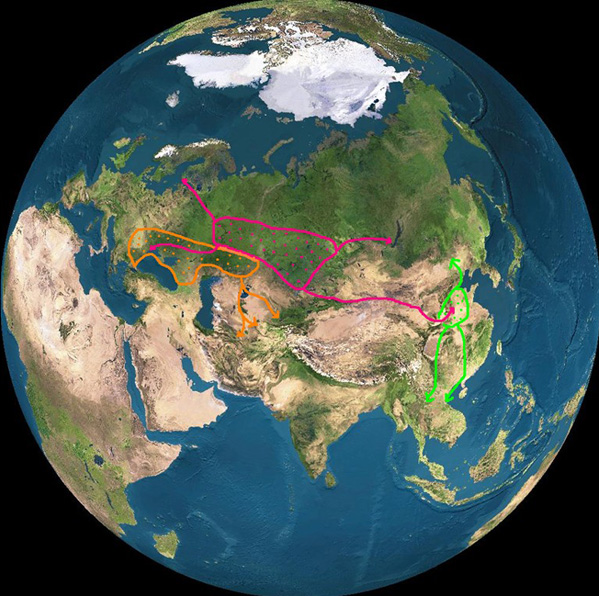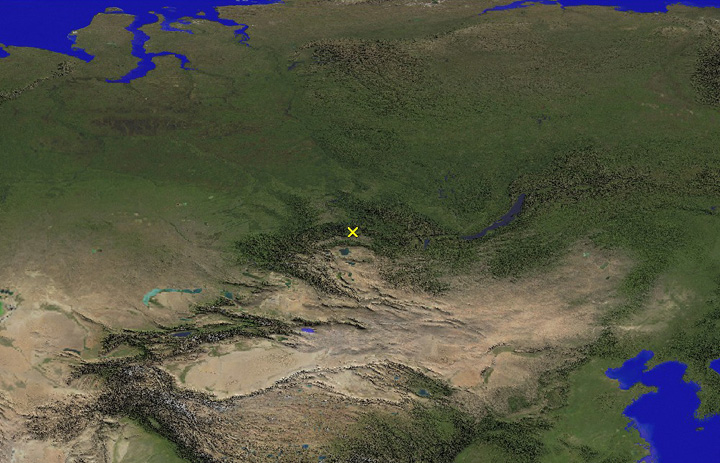The two "nuclear areas" of Old World development were the Fertile Crescent of western Asia, and central China (the Yangtse and Huang-He valleys). Farming began independently in each of them during the early Holocene, based on wheat/barley and rice/millet respectively, with complementary local legumes and domestic animals. Both areas initiated a process of population expansion (see Contagious Processes) associated with the spread of cultivation practices and the incorporation of new species of crops and livestock. For a combination of reasons (including the topographic constriction of China and because of the greater diversity of domesticates in the western Old World), the complex centred in the Fertile Crescent spread more rapidly than that centred on China.
The range of domestic animals in the west gave it a particular advantage in occupying the steppe belt across Eurasia, which began slowly during the later fourth and third millennia BC, but accelerated in the early second millennium with the development of horse-drawn vehicles on spoked wheels. In parallel to this, in the taiga and forest-steppe zone to the north, an important network of contacts stretched from the Ural mountains to the Altai, and gave rise to a common north-Eurasian metallurgical tradition based on the hollow casting of bronzes (See: http://www.csen.org/koryakova2/Korya.Bronze.html). This was the ancestor both of the Chinese bronze-casting tradition for ritual vessels of the Shang and Chou periods, and of advanced types of hollow-cast weapons and tools (spearheads, axes) in northern Europe. A further impact on Chinese technology was the incorporation of the steppe chariot-complex in the later Shang period (See: http://www.rom.on.ca/pub/shang/). Contacts between the western and eastern ends of Eurasia were thus established across the intervening region at the time of the Bronze Age civilizations in each area, and account for certain common features, despite the very different character of these societies.

1) Trans-Eurasian contacts in the early second millennium BC. The area outlined in red indicates the area of Seima-Turbino metallurgy, from the Urals to the Altai, with arrows indicating the extent of some of its typical products (e.g. socketed spearheads), found as far apart as the eastern Baltic, Bessarabia, the Baikal region and China. The area outlined in orange indicates an early phase of expansion in the steppe zone, associated with the Andronovo culture. Green arrows in China indicate the subsequent spread of bronze weaponry based on this technology.
An important phase in the linkage of the two ends of Eurasia was the development of nomadic pastoralism in the steppe corridor, at the end of the second millennium and the beginning of the first millennium. Initiated at the eastern end of the corridor, and manifested in the emergence of spectacular tumulus burials on the southern edges of the Altai mountains (See: http://www.dainst.org/index_596_en.html), this complex was associated with horse-riding and a mobile way of life using the typical felt tent (yurt). All across Eurasia iron came into use as a useful metal, although in China it only slowly displaced bronze e.g. for weapons. Expansion of the nomad-pastoral complex across the steppes created an effect on the Iron Age societies of western Eurasia (just as it did on China), with the impact of the Cimmerians and Scythians as the first wave of successively powerful steppe tribes who formed a major bloc in central Eurasia.

2) Sited at the interface between mountains and plains, forest and steppe, the 7th century BC royal burial-mound of Arzhan marks the axial importance of this area in the new network of relations which grew up around the emergence of pastoral nomadism on the steppes, linking east and west.
The third strand in the series of links across Eurasia was created at the end of the first millennium BC, and came fully into existence in the first millennium AD. This was the bundle of routes collectively known as the Silk Road (Route de la Soie), and intimately connected with the emergence of India as another major intervening area of urban civilization, linked to the Mediterranean by the maritime Spice Route (which developed by extension the earlier overland Incense Route through Arabia). Both of these routes brought desirable Chinese products (not only silk) to the west, and created the first commercial ties – albeit indirect, and through many intermediaries – between the two ends of Eurasia. The overland route arose by the joining of two much earlier long-distance routes, which had existed since the Bronze Age: the route bringing lapis lazuli from Badakhshan to the Near East, and the route which supplied Khotan jade to China. These two sources of these precious materials were separated by the "Pamir knot" – an exceptionally complex and difficult part of the chain of mountains running between Iran and the Himalayas. With the urbanization of Bactria (the ultimate conquest of Alexander the Great), it became worthwhile to develop routes across the passes which gave access to the oases of the Tarim Basin. These formed a chain of links through Gansu down to central China, and so developed to become a great artery of contacts between east and west. No merchant traveled along the whole length of the Silk Road (before the 12th century AD, under the Pax Mongolica), but it operated as a giant version of prehistoric "down the line" routes, with goods traveling along its different segments because of the strong price differential along the line. Exchanges reached a climax under Sasanian rule in Iran and the T'ang dynasty in China, when grape-wine and sheet-metal silver drinking-vessels traveled eastwards, and created a major technical and stylistic transformation in Chinese metalwork. The shapes developed for elegant silver cups were successfully translated into pottery, and the high-temperature firing techniques were applied to produce a new, elegant, thin-walled white pottery. As commercial contacts between China and the west intensified, and bulk transport by sea became possible (see Portages), China began to exporting two complementary commodities for international consumption – tea, and porcelain.

3) The chain of commercial connections which extended across Eurasia in the first millennium AD, collectively known as the Silk Road, linked the ancient civilizations of China and the Near East, between the "anchor sites" which developed at either end, Xi'an (Chang'an) and Baghdad.
 Occasional Papers (2009-)
Occasional Papers (2009-) Site Visualisations
Site Visualisations